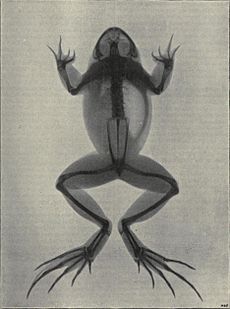Edward Waymouth Reid facts for kids
Edward Waymouth Reid (born October 11, 1862, in Canterbury; died March 10, 1948, in Edinburgh) was an important British scientist. He was a physiologist, which means he studied how living things work. He was also a Fellow of the Royal Society, a very respected group for scientists.
Contents
Early Life and Education
Edward Waymouth Reid was born in 1862. He was the fourth son of James Reid. Edward went to Sutton Valence Grammar School. In 1879, he started studying at Cavendish College at the University of Cambridge. He earned his first degree, a Bachelor of Arts (B.A.), in 1883.
Starting His Medical Career
In 1885, Edward qualified as a doctor. He earned his M.B. and M.R.C.S. degrees at St Bartholomew's Hospital. He also worked there as an assistant electrician. Later, he moved to St Mary's Hospital. From 1885 to 1887, he taught physiology as a demonstrator. Then, from 1887 to 1889, he became a lecturer in physiology.
Becoming a Professor in Dundee
When he was only 27 years old, Edward Waymouth Reid got a big job. He was chosen to lead the new physiology department at University College, Dundee. This college was connected to the University of St. Andrews. He worked there for 46 years. After he retired in 1935, the University of St Andrews gave him an honorary degree. This was to thank him for his long service.
Pioneering Science Discoveries
Edward Waymouth Reid was a very active researcher. He studied how living tissues work. He looked at things like electricity in the heart. He also invented a special device called a recording osmometer. This device helped him study how liquids move through tiny membranes.
Early X-ray Experiments
While he was in Dundee, Reid worked with a Dutch physicist named Johannes Kuenen. They did some of the very first experiments with x-rays. Their work helped people understand more about these new rays.

Understanding How Cells Absorb Things
Reid did important research on how materials move across surfaces in the body. He studied processes like diffusion, osmosis, and filtration. He was one of the first scientists to use special parts of the intestine to study how nutrients are absorbed. He found that salt (NaCl) was very important for this process.
His work on how cells actively transport substances was ahead of its time. People didn't fully understand how important his discoveries were until the 1950s. He was a true pioneer in this field.
A Sweet Secret Project
Edward Waymouth Reid had a fun secret project. He used his laboratory at University College to make sweets! He sold these sweets in the Dundee Student's Union. He used the money he earned to help fund the College's playing field. For this project, he used a funny fake name: Herr Doktor Bimstein Pumpduluder.
Achievements and Recognition
In 1898, Edward Waymouth Reid was elected a Fellow of the Royal Society (FRS). This is a very high honor for a scientist. In 1904, he earned his Sc.D. degree from Downing College, Cambridge. He also served as the Dean of the Medical Faculty at the University of St Andrews.

